List of Chinese flags
This is a list of flags of entities named "China".
National flags
| Flag | Duration | Use | Description |
|---|---|---|---|
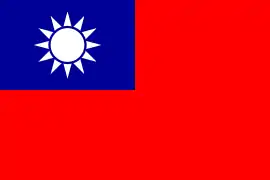 | 30 June 1924–present | Flag of the Republic of China | Commonly known as "Taiwan". A red field, with a blue canton containing a 12-ray white sun. This flag flew over mainland China until 1949, and is presently flown on the island of Taiwan and other islands under the control of the ROC. This flag can be sometimes be seen in Mainland China, for historical and unofficial use. |
 | 1 October 1949–present | Flag of the People's Republic of China | Commonly known as "China" locally known as "Sino". A red field, with a large yellow star with four smaller stars to the right at the canton. This flag is flown in mainland China, Hong Kong, and Macau. |
Imperial flags
| Flag | Duration | Use | Description |
|---|---|---|---|
.svg.png.webp) |
1862–1890 | The flag of Qing dynasty | Azure Dragon on a plain right triangle yellow field with the red sun of the three-legged crow in the upper left corner. |
.svg.png.webp) |
1890–1912 | The flag of Qing dynasty | Rectangular variant of above flag. |
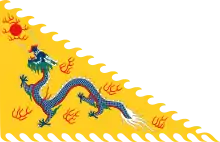 |
1862–1912 | Standard of the Qing Emperor | Qing dynasty imperial standard for the Emperor of China. |
Provinces
Since the PRC-controlled mainland lacks provincial flags, only the ROC-controlled areas have two flags of its provinces.
| Flag | Duration | Use | Description |
|---|---|---|---|
 | Fujian Province | Only used in the ROC-controlled Fujian after 1949. | |
 | Taiwan Province |
Special administrative regions flags
| Flag | Duration | Use | Description |
|---|---|---|---|
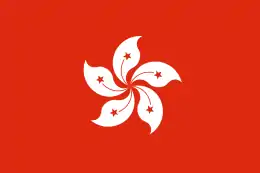 | 1 July 1997–present | Flag of Hong Kong | A white, five-petal Bauhinia blakeana on a red field with 1 star on each of the petals. The Chinese name of Bauhinia × blakeana has also been frequently shortened as 紫荊/紫荆 (洋 yáng means "foreign" in Chinese, and this would be deemed inappropriate by the PRC government), although 紫荊/紫荆 refers to another genus called Cercis. A statue of the plant has been erected in Golden Bauhinia Square in Hong Kong. |
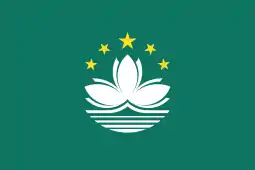 | 20 December 1999–present | Flag of Macau | A lotus flower above a stylized bridge and water in white, beneath an arc of five gold, five-pointed stars on a green field |
City and county flags
As of 18 November 1997, the Chinese Government banned localities from making and using local flags and emblems.[1] Despite this law, some cities have adopted their own flag that often includes their local emblem as shown below. The ROC-controlled areas continues to use the respective flags.
| Flag | Duration | Use | Description |
|---|---|---|---|
 | May 1997–January 1998 | Flag of Harbin[2] | A white, five-petal flower surrounding a snowflake on a dark green field |
 | December 1995–present | Flag of Suzhou[3] | |
.svg.png.webp) | December 1986–present | Flag of Nanjing[4] | Still used in 2014 Summer Youth Olympics. |
 | March 2009–present | Flag of Shangrao | |
 | March 2006–present | Flag of Kaifeng | |
 | 2010– | Kaohsiung City
高雄市 |
Stylized "高". Colors symbolizing sunshine, vitality, environmental protection, & ocean.
http://www.kcg.gov.tw/CP.aspx?n=1FA00AF1B01EEB41&s=B5FC50A1C806D74A |
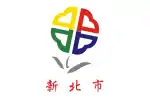 | 2010– | New Taipei City
新北市 |
Highly stylized "北" in the form of four hearts arranged to resemble a four-leaf clover. |
 | 2008– | Taichung City | |
 | 2010– | Tainan City | |
 | 2010– | Taipei City | |
 | 2014– | Taoyuan City | |
 | Chiayi City | ||
 | Hsinchu City | ||
 | Keelung City | ||
 | Changhua County | ||
 | Chiayi County | ||
 | Hsinchu County | ||
 | Hualien County | ||
 | Kinmen County | ||
 | Lienchiang County | ||
 | Miaoli County | ||
 | Nantou County | ||
 | Penghu County | ||
 | Pingtung County | ||
 | Taitung County | ||
 | Yilan County | ||
 | Yunlin County |
Military flags
| Flag | Duration | Use | Description |
|---|---|---|---|
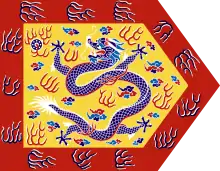 |
1615–1911 | Flag of the Bordered Yellow Banner of the Eight Banners | The Eight Banners was created in the early 17th century by Nurhaci to unify the Jurchen people into the Manchu dynasty. The first three banners were under the direct command of the Emperor himself. |
 |
1615–1911 | Flag of the Plain Yellow Banner of the Eight Banners | |
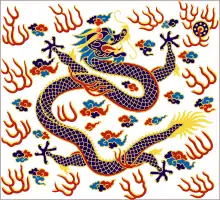 |
1615–1911 | Flag of the Plain White Banner of the Eight Banners | |
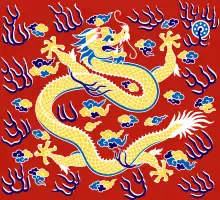 |
1615–1911 | Flag of the Plain Red Banner of the Eight Banners | |
 |
1615–1911 | Flag of the Bordered White Banner of the Eight Banners | |
 |
1615–1911 | Flag of the Bordered Red Banner of the Eight Banners | |
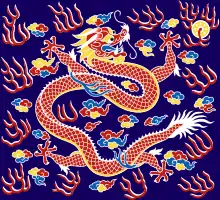 |
1615–1911 | Flag of the Plain Blue Banner of the Eight Banners | |
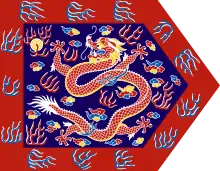 |
1615–1911 | Flag of the Bordered Blue Banner of the Eight Banners | |
.svg.png.webp) |
1862–1890 | Used on Qing Dynasty naval ships for identification | Same as national flag. |
.svg.png.webp) |
1890–1912 | The flag of the Qing Imperial Chinese Navy | Square version of above flag. |
 |
1874–1890 | The flag of the Admiral of the Beiyang Fleet from 1874–1890. | |
 |
1890–1909 | The flag of the Admiral of the Beiyang Fleet from 1890–1909. | |
.svg.png.webp) |
1909–1911 | The flag of the Admiral of the Beiyang Fleet from 1909–1911. | |
_18_dots.svg.png.webp) _19_dots.svg.png.webp) | 1911–1928 | Flag of the Wuchang uprising; army flag of the Republic of China | The banner of the Wuchang uprising of October 10, 1911, subsequently used as the flag of the army of the Republic of China, ca. 1913–28. |
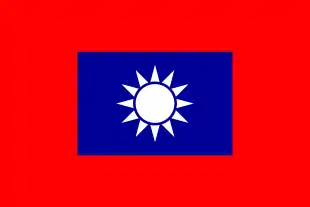 | 1924–present | Flag of the Republic of China Army (formerly National Revolutionary Army) | The Blue Sky with a White Sun with a red border. |
 | 1924–present | Naval Jack of the Republic of China Navy | Identical to the Kuomintang flag (see below). |
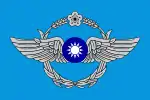 | 1924–present | Flag of the Republic of China Air Force | |
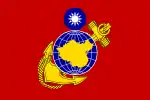 | 1924–present | Flag of the Republic of China Marine Corps | |
 | 1924–present | Flag of the Republic of China Military Police | |
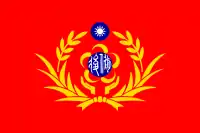 | 1945–present | Flag of the Republic of China Armed Forces Reserve | |
 | 1946–2012 | Flag of the Republic of China Joint Logistics Command | |
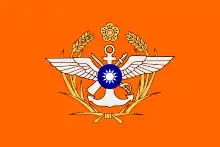 | 1924–present | Flag of the Ministry of National Defense of the Republic of China (Republic of China Armed Forces) | |
 | 2000–present | Flag of the Coast Guard Administration of the Republic of China | |
.svg.png.webp) | 1912–1928 | Flag of the Republic of China Police (1912–1928) | |
.svg.png.webp) | 1932–1947 | Flag of the Republic of China Police (1932–1947) | |
.svg.png.webp) | 1947–1974 | Flag of the Republic of China Police (1947–1974) | |
 | 1974–present | Flag of the Republic of China Police (1974–present) | |
| 1927–1928 | Flag of the Chinese Workers' and Peasants' Red Army | Same as 1928 version but left side read 工農革命軍 (China Workers'/Peasants' Revolutionary Army). Divisions were added, for example 第二軍第一師 (Second Army, 1st Division). | |
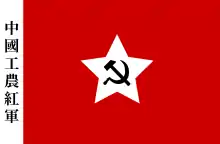 | 1928–1930 | Flag of the Chinese Workers' and Peasants' Red Army | Left side reads 中國工農紅軍 (Chinese Workers' and Peasants' Red Army). |
| 1930 | Flag of the Chinese Workers' and Peasants' Red Army | Same as 1928 version but left side has no characters and top reads 全世界無產階級聯合起來 (The world's proletariat, unite!). | |
| 1930–1931 | Flag of the Chinese Workers' and Peasants' Red Army | Same as April 1930 version but top reads 全世界無產階級及被壓迫民族聯合起來 (The world's proletariat and oppressed nations, unite!). | |
| 1931–1934 | Flag of the Chinese Workers' and Peasants' Red Army | Same as 1934 version but with blank white left side and colored fringe around the edges (6 variants - red for infantry, yellow for cavalry, black for artillery, white for engineering, blue for logistics, green for medical). | |
 | 1934–1937 | Flag of the Chinese Workers' and Peasants' Red Army | |
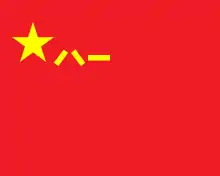 | 1948–present | Flag of the People's Liberation Army | A red field with a yellow star at the canton, and the Chinese numerals for "8" and "1", the date of the PLA's establishment on 1 August 1927. |
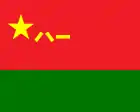 | 1992–present | Flag of the People's Liberation Army Ground Force | The PLA flag with a green stripe at the bottom. |
.svg.png.webp) | 1950s | Flag of the People's Liberation Army Navy | The red flag with PLA emblem and a blue stripe in the center. |
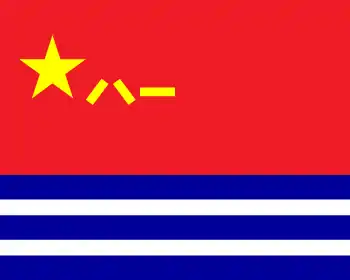 | 1992–present | Ensign of the People's Liberation Army Navy | The PLA flag with 5 horizontal lines, 3 blue and 2 white at the bottom, representing the sea. |
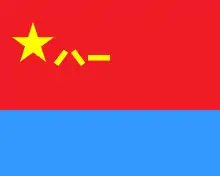 | 1992–present | Ensign of the People's Liberation Army Air Force | The PLA flag with a blue stripe at the bottom, representing the sky. |
 | 2016–present | Ensign of the People's Liberation Army Rocket Force | The PLA flag with a gold yellow stripe at the bottom, representing the flare of missile launching. |
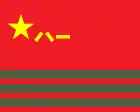 | 2018–present | Ensign of the People's Armed Police Force | The PLA flag with three green bars at the bottom. |
Proposed national flags of the Republic of China
.svg.png.webp) Teo Eng Hock and his wife's proposal 1 for the ROC flag.
Teo Eng Hock and his wife's proposal 1 for the ROC flag..svg.png.webp) Proposal 2 for the ROC flag.
Proposal 2 for the ROC flag. Proposal 3 for the ROC flag, later adopted as the Flag of the Republic of China Army.
Proposal 3 for the ROC flag, later adopted as the Flag of the Republic of China Army. Proposal 4 for the ROC flag, later officially adopted as the national flag.
Proposal 4 for the ROC flag, later officially adopted as the national flag.
Proposed national flags of the People's Republic of China
In July 1949, a contest was announced for a national flag for the newly founded People's Republic of China (PRC). From a total of about 3,000 proposed designs, 38 finalists were chosen. In September, the current flag, submitted by Zeng Liansong, was officially adopted, with the hammer and sickle removed.[5]
Alternative proposals
 Mao Zedong's proposal for the PRC flag.
Mao Zedong's proposal for the PRC flag.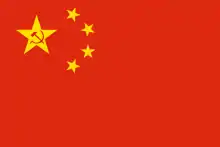 Zeng Liansong's original proposal for the PRC flag.
Zeng Liansong's original proposal for the PRC flag. Proposal 2 for the PRC flag.
Proposal 2 for the PRC flag. Proposal 3 for the PRC flag.
Proposal 3 for the PRC flag. Proposal 4 for the PRC flag.
Proposal 4 for the PRC flag.
Selection of proposals
 Design by Ai Qing
Design by Ai Qing Design by Bao Qiquan
Design by Bao Qiquan Design by Chen Duo
Design by Chen Duo Design by Chen Lu
Design by Chen Lu Design by Guo Moruo
Design by Guo Moruo Design by Guo Moruo
Design by Guo Moruo Design by Hu Yuanqing
Design by Hu Yuanqing Design by Jiang Dazhong
Design by Jiang Dazhong Design by Kang Jian
Design by Kang Jian Design by Liang Congjie
Design by Liang Congjie Design by Luo Wen
Design by Luo Wen Design by Mo Hongshu
Design by Mo Hongshu Design by Mo Zongjiang
Design by Mo Zongjiang Design by Pang Xunqin
Design by Pang Xunqin Design by Wu Yuzhang
Design by Wu Yuzhang Design by Wu Yuzhang
Design by Wu Yuzhang Design by Xiao Shufang
Design by Xiao Shufang Design by Xiao Shufang
Design by Xiao Shufang Design by Xiao Shuhua
Design by Xiao Shuhua Design by Xiao Shuhua
Design by Xiao Shuhua Design by Yan Xinghua
Design by Yan Xinghua Design by Yang Taiyang
Design by Yang Taiyang Design by Yang Taiyang
Design by Yang Taiyang Design by Yu Zhuosheng
Design by Yu Zhuosheng Design by Zhang Ding and Zhong Ling
Design by Zhang Ding and Zhong Ling Design by Zhang Ding and Zhong Ling
Design by Zhang Ding and Zhong Ling Design by Zhang Ding and Zhong Ling
Design by Zhang Ding and Zhong Ling Design by Zhang Ding and Zhong Ling
Design by Zhang Ding and Zhong Ling Design by Zhang Ding and Zhong Ling
Design by Zhang Ding and Zhong Ling Design by Zhang Ding, Zhong Ling and Zhou Guangyuan
Design by Zhang Ding, Zhong Ling and Zhou Guangyuan Design by Zhang Ding, Zhong Ling and Zhou Guangyuan
Design by Zhang Ding, Zhong Ling and Zhou Guangyuan Design by Zhang Ding, Zhong Ling, Zhou Guangyuan and Xiao Shuhua
Design by Zhang Ding, Zhong Ling, Zhou Guangyuan and Xiao Shuhua Design by Zhu De
Design by Zhu De























Non-state flags
| Flag | Duration | Use | Description |
|---|---|---|---|
 | 1895–present | Flag of the Kuomintang | The "Blue Sky with a White Sun", 12 rays of the sun represent progressive ideals. |
 | 1996–present | Flag of the Communist Party of China | Communist hammer and sickle. |
.svg.png.webp) | 1921–1996 | Flag of the Communist Party of China | Communist hammer and sickle. |
.svg.png.webp) | 1949–present | Flag of Young Pioneers of China | Red flag with yellow five-pointed star and torch in the middle. |
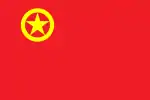 | 1922–present | Flag of Communist Youth League of China | Red flag with encircled yellow five-pointed star. |
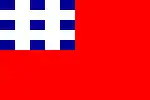 | 1925–1953 | Flag of the China Party for Public Interest | 井 |
 | 1946 | China Democratic Socialist Party flag | # |
.svg.png.webp) | 1927–1928 | Commander-in-Chief Flag of the Republic of China (Beiyang Government) | |
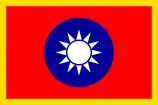 | 1929–present | Standard of the President of the Republic of China | |
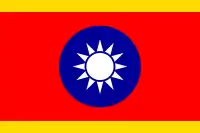 | 1947–1986 | Standard of the Vice President of the Republic of China | Abolished with Act of Ensign of the Republic of China Navy (海軍旗章條例) on Jan. 3rd, 1986. |
 | 1929–1966 | Civil Ensign of the Republic of China | Four serrated yellow stripes are added to the flag of the Republic of China for use as a civil ensign at sea. Present civil ensign is national flag. |
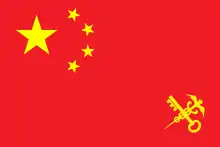 | 1950s–present | Flag of the Customs of the People's Republic of China | The caduceus crossed with a golden key is added to flag of the People's Republic of China. |
 | 2018–present | Flag of the China Fire and Rescue Service | Bicolor flag in red and blue with the badge of the China Fire and Rescue Service at the top and the bilingual text "Flag of China Fire and Rescue" at the bottom. |
 | 2020–present | Flag of the People's Police of the People's Republic of China | Red flag with a blue stripe in the bottom and the badge of the People's Police in the canton. |
Historical national flags
| Flag | Duration | Use | Description |
|---|---|---|---|
.svg.png.webp) | 1862–90 | Flag of the Qing Dynasty | Naval flag, quasi-national flag on international occasions. |
.svg.png.webp) | 1889–1912 | Flag of the Qing Dynasty | Official national flag since 1889. |
.svg.png.webp) | 1912–28 | First flag of the Republic of China, or "Five-colored flag" | It was widely flown even before the Republic of China in Shanghai and eastern parts of north China until 1928. The stripe representation: red for Han Chinese, yellow for Manchus, blue for Mongols, white for Hui and black for Tibetans. Later used by the Japanese puppet states of the East Hebei Autonomous Government, the Chinese Provisional Government and Reformed Government of China. |
.svg.png.webp) | 1916 | Flags of Empire of China. | The version with the red saltire was more commonly used than the version with the red centered cross. |
 | Mainland China: 1924–49 Taiwan: 1945–present | Flag of the Republic of China; Naval Ensign | Naval Ensign from 1913 for the Republic of China. Not used in areas administrated by the People's Republic of China except in historical venues. Currently used as the national flag of the Republic of China. |
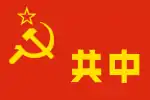 | 1931–34 | Jiangxi Soviet republic flag | A red star and hammer and sickle along with Chinese characters for "Chinese Communists" (Zhonggong, 中共) written in classical word order, i.e., read from the right. |
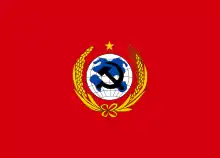 | 1931–34 | Flag of Chinese Soviet Republic | Red flag with the national emblem in the center. |
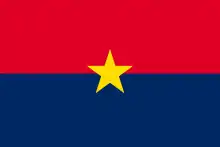 | 1933–34 | Flag of Fujian People's Government | A horizontal bicolour of red and blue and charged with a yellow five-pointed star in the center. |
Other historical flags
| Flag | Duration | Use | Description |
|---|---|---|---|
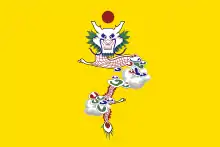 | 1851–1864 | Flag of the Taiping Heavenly Kingdom | Used by the Taiping Heavenly Kingdom until 1864. |
.svg.png.webp) | 1897–1914 | Flag of Tsingtau, Kiautschou[6] | Imperial War Flag of the German Empire. |
 | 1897–1914 | Flag of the Governor of Tsingtau[7] | Gouverneurflagge of the German Empire. |
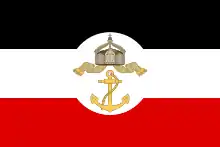 | 1897–1914 | Civil flag of Tsingtau, Kiautschou[8] | Reichskriegsflagge der Kaiserliche Marine of the German Empire. |
 | 1903–1930 | Flag of the Weihaiwei | A British Blue Ensign with two Mandarin ducks standing on a beach. |
.svg.png.webp) | 1870–1876 | Flag of the British colony of Hong Kong | A British Blue Ensign with a crowned "HK" in a white disc. |
.svg.png.webp) | 1876–1955 | Flag of the British colony of Hong Kong | A British Blue Ensign with local waterfront scene. |
.svg.png.webp) | 1955–1959 | Flag of the British colony of Hong Kong | A British Blue Ensign with local waterfront scene. |
.svg.png.webp) | 1959–1997 | Flag of the British colony of Hong Kong | A British Blue Ensign with the coat of arms of Hong Kong (granted in 1959) in a white disc. |
 | 1985–1999 | Flag of the Regional Council (Hong Kong) | A stylized Bauhinia blakeana leaf outline in white, in the form of a diagonally-tilted capital "R", on a green background, representing the green of the leaves. |
 | 1960s–1999 | Flag of the Urban Council (Hong Kong) | A stylized Bauhinia blakeana flower outline in white on a pink background representing sacredness, dignity, and love while implying harmonious coexistence of Chinese and Westerners. |
.svg.png.webp) | 1910–1941, 1945–1959 | Flag of the Governor of Hong Kong | An Union Jack defaced with the colonial badge of Hong Kong and surrounded by a green wreath. |
.svg.png.webp) | 1959–1997 | Flag of the Governor of Hong Kong | An Union Jack defaced with the coat of arms of Hong Kong in a white disc and surrounded by a green wreath. |
.svg.png.webp) | 1670–1830 | Flag of Portugal, used in colonial era colony of Macau | The Portuguese flag was used in colonial-era Macau, as there was no territorial flag. |
.svg.png.webp) | 1830–1911 | Flag of Portugal, used in colonial era colony of Macau | The Portuguese flag was used in colonial-era Macau, as there was no territorial flag. |
 | 1911–1999 | Flag of Portugal, used in colonial era colony of Macau | The Portuguese flag was used in colonial-era Macau, as there was no territorial flag. |
 | 1975–1999 | Flag of the Municipality of Macau, one of two local municipal governments. | A light blue field charged with the coat of arms of the Municipality of Macau. This was the flag used at the handover to China in 1999. |
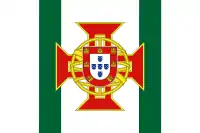 | Until 1999 | Flag of the Governor of Macau | A white field with two green vertical stripes charged with an Order of Christ Cross bearing the coat of arms of Portugal. |
.svg.png.webp) | 1975–1999 | Flag of Portuguese colonial Government of Macau. | A light blue field charged with the coat of arms of the Government of Macau. During the Portuguese administration this flag also represented the Territory of Macau in the international forums, although it was not the official flag of the Portuguese colony. |
 | 1975–1999 (Not Official) | Variant flag of Portuguese colonial Government of Macau. | Not official variant without the Kingdom of the Algarve castles in the coat of arms. This flag was found at the University of Macau in a photo of International University sports meeting and it was used in the parade. Although this flag was never used officially, some sports media used it instead of the Portuguese Flag to represent the colony. |
.svg.png.webp) | 1897–1915 | Flag of the Chinese Eastern Railway | A combination of the triangular version of the flag of the Qing dynasty and the flag of Russia, with the text "East Provinces' Railway of Great Qing" in Chinese. |
.svg.png.webp) | 1915–1925 | Flag of the Chinese Eastern Railway | A combination of the triangular version of the Five Races Under One Union flag and the flag of Russia, with the text "East Provinces' Railway Company of China" in Chinese. |
.svg.png.webp) | 1925–1932 | Flag of the Chinese Eastern Railway | A combination with the Five Races Under One Union flag at the top and the flag of Soviet Union at the bottom. |
.svg.png.webp) | 1932–1935 | Flag of the Chinese Eastern Railway | A combination with the flag of Manchukuo at the top and the flag of Soviet Union at the bottom. |
.svg.png.webp) |
1849–1943 (in Shanghai) 1898–1943, 1945–1946 (in Guangzhouwan) |
Flag of France, used in Shanghai French Concession and French Guangzhouwan. | The French flag was used in Shanghai French Concession and French Guangzhouwan, as there were no territorial flag. |
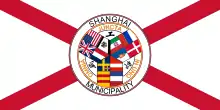 | 1869 – c. 1917 | Flag of Shanghai Municipal Council, Shanghai International Settlement | |
 | c. 1917 – 1943 | Flag of Shanghai Municipal Council, Shanghai International Settlement | |
.svg.png.webp) | until 29 December 1928 | Flag of Fengtian clique. | Used by warlords until Chinese reunification (1928). |
.png.webp) | 1922–1949 | Flag of Kunming[9] | The flag features the former city emblem which consists of two intersecting red circles which represent the harmony of sun and moon, as well as western and eastern ideas. In the middle is a golden stylized symbol of a 市 character. |
 | 1933–1942 | Flag of Xinjiang | Used by Sheng Shicai's provincial government in Xinjiang until 1942. |
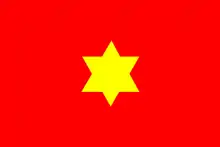 | 1942–1944 | Flag of Xinjiang | Used by the Sheng Shicai's provincial government in Xinjiang until 1944. |
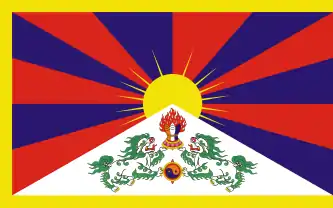 | 1916–1951 | Flag of Tibet. | Used by Tibet until 1951. Currently used by the Tibetan Government in Exile located in Dharamshala, India |
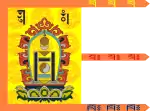 | 1911–1920 | Flag of the Bogd Khanate of Mongolia. | Flag of the Bogd Khanate of Mongolia after its declaration of independence during the fall of the Chinese Qing dynasty. The flag's exact design was not standardized and variations occurred from flag to flag.[10][11][12] |
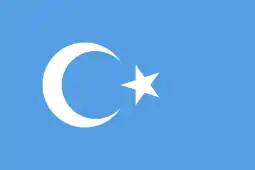 | 1933–1934 | Flag of the First East Turkestan Republic | Used by the First East Turkestan Republic until 1934. |
 | 1944–1946 | Flag of the Second East Turkestan Republic | Used by the Second East Turkestan Republic until 1946. |
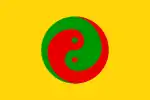 | 1937–1938 | Flag of the Great Way Government. | |
.svg.png.webp) | 1936–1939 | Flag of the Mongol Military Government, which became the Flag of the Mongol United Autonomous Government in 1937. | A vertical pattern of red, yellow, white as a canton on a blue field. |
 | 1938–1939 | Flag of the South Chahar Autonomous Government, also known as Chanan. Later merged with the Mongol United Autonomous Government and Jinbei to create Mengjiang | A vertical pattern of red, white, blue as a canton on a yellow field. |
 | 1938–1939 | Flag of the North Shanxi Autonomous Government, also known as Jinbei. Later merged with the Mongol United Autonomous Government and Chanan to create Mengjiang | A vertical pattern of red, blue, white as a canton on a yellow field. |
 | 1939–1945 | Flag of Mengjiang | A horizontal pattern of yellow, blue, white, red, white, blue, and yellow again. |
.svg.png.webp) | 1940–1943 | Flag of the Reorganized National Government of the Republic of China. | Used by the Japanese puppet government until 1943 when the pennant was removed and the regular ROC flag took its place. The pennant reads "Peace, Anti-Communism, National Construction". |
.svg.png.webp) | 1940–1943 | Flag of the Reorganized National Government of the Republic of China. | Used by the Japanese puppet government until 1943 when the pennant was removed and the regular ROC flag took its place. The pennant reads "Peace, Anti-Communism". |
.svg.png.webp) | 1940–1943 | Flag of the Reorganized National Government of the Republic of China. | Used by the Japanese puppet government until 1943 when the pennant was removed and the regular ROC flag took its place. The pennant reads "Peace, National Construction". |
.svg.png.webp) | 1942–1945 | War Ensign of the Reorganized National Government of the Republic of China. | Used by the Japanese puppet government from 1 May 1942 until the end of the regime. |
Note that Hong Kong and Macau were handed over to the People's Republic of China in 1997 and 1999 respectively.
Manchukuo flags
| Flag | Duration | Use | Description |
|---|---|---|---|
 | 1932–1945 | Flag of Manchukuo | A yellow field with the red, blue, white, and black stripes of the first flag of the Republic of China (see above) in the canton. |
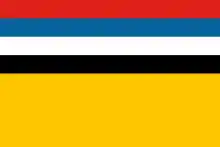 | 1932–1945 | War ensign of Manchukuo. | Used by the Manchukuo Imperial Army. |
 | 1932–1945 | Flag of the Manchukuo Shipping Office. | Used by the Manchukuo Shipping Office. |
 | 1932–1945 | Flag of the Manchukuo Coast Guard. | Used by the Manchukuo Coast Guard. |
 | 1932–1945 | Flag of the Manchukuo Marine Police | Used by the Manchukuo Marine Police. |
 | 1932–1945 | Flag of the Manchukuo Post | Postal flag of Manchukuo. |
 | 1932–1945 | Imperial standard of the Emperor of Manchukuo. | Used by the Emperor of Manchukuo. |
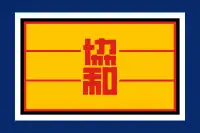 | 1931–1945 | Flag of the Concordia Association. | Used by the Concordia Association of Manchukuo. |
 | 1932–1945 | Flag of the Boy Scouts of Manchukuo. | Used by the Boy Scouts of Manchukuo. |
See also
References
- 中共中央办公厅、国务院办公厅关于禁止自行制作和使用地方旗、徽的通知 (Chinese Communist Central Governmental Notice to Ban Making and Using Local Flags and Emblems)
- 哈尔滨市市旗市徽制作和使用管理暂行办法 Archived 2005-03-21 at the Wayback Machine
- "蘇州市城鄉建設檔案館". Archived from the original on 2014-04-13. Retrieved 2012-02-18.
- 市徽图案废止后著作权的归属
- 《中华人民共和国国旗国徽国歌档案》,中央档案馆编,中国档案出版社出版,2009。
- Kiautschou Tsingtau
- Kiautschou Tsingtau
- Kiautschou Tsingtau
- |date=2020-04-26 }}
- "Flag of Bogd Khaanate Mongolia (1)". markodehaeck.free.fr. Retrieved 1 January 2019.
- "Flag of Bogd Khaanate Mongolia (2)". markodehaeck.free.fr. Retrieved 24 January 2019.
- "Flag of Bogd Khaanate Mongolia (3)". markodehaeck.free.fr. Retrieved 24 January 2019.
External links
 Media related to Flags of China at Wikimedia Commons
Media related to Flags of China at Wikimedia Commons- China: Index of Pages at Flags of the World